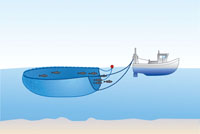 Purse seines are large, vertically floating nets (made of monofilament or plastic) which boats use to surround shoals of fish they have identified on a fish finding sonar. Each net can be up to one mile long. Once fish are in the net, the base is drawn together, creating a ‘purse’. This method catches large volumes of fish. It is also used for catching live tuna for ongrowing in pens (called ‘ranching’).
Purse seines are large, vertically floating nets (made of monofilament or plastic) which boats use to surround shoals of fish they have identified on a fish finding sonar. Each net can be up to one mile long. Once fish are in the net, the base is drawn together, creating a ‘purse’. This method catches large volumes of fish. It is also used for catching live tuna for ongrowing in pens (called ‘ranching’).
Examples of target species
- Tuna (both for direct capture and ranching), herring, mackerel.
Environmental summary
- Habitat damage - purse seines do not come into contact with the seabed so are not associated with damage to marine habitat.
- Bycatch of vulnerable species - depending on the fishery, purse seines may catch vulnerable species; purse seining targeting tuna has been particularly associated with notable bycatch of mammals and sharks.
- Discards - purse seining can be associated with bycatch of non-target fish and other marine life and the accidental catch and discarding of juvenile commercial fish species.
Mitigation
In some fisheries, observers on board tuna purse seiners check that there is minimal dolphin catch in the nets during fishing.
Good Catch: Good Catch provides practical information for chefs, caterers and restaurateurs, making it easier for them to serve more sustainable seafood.
